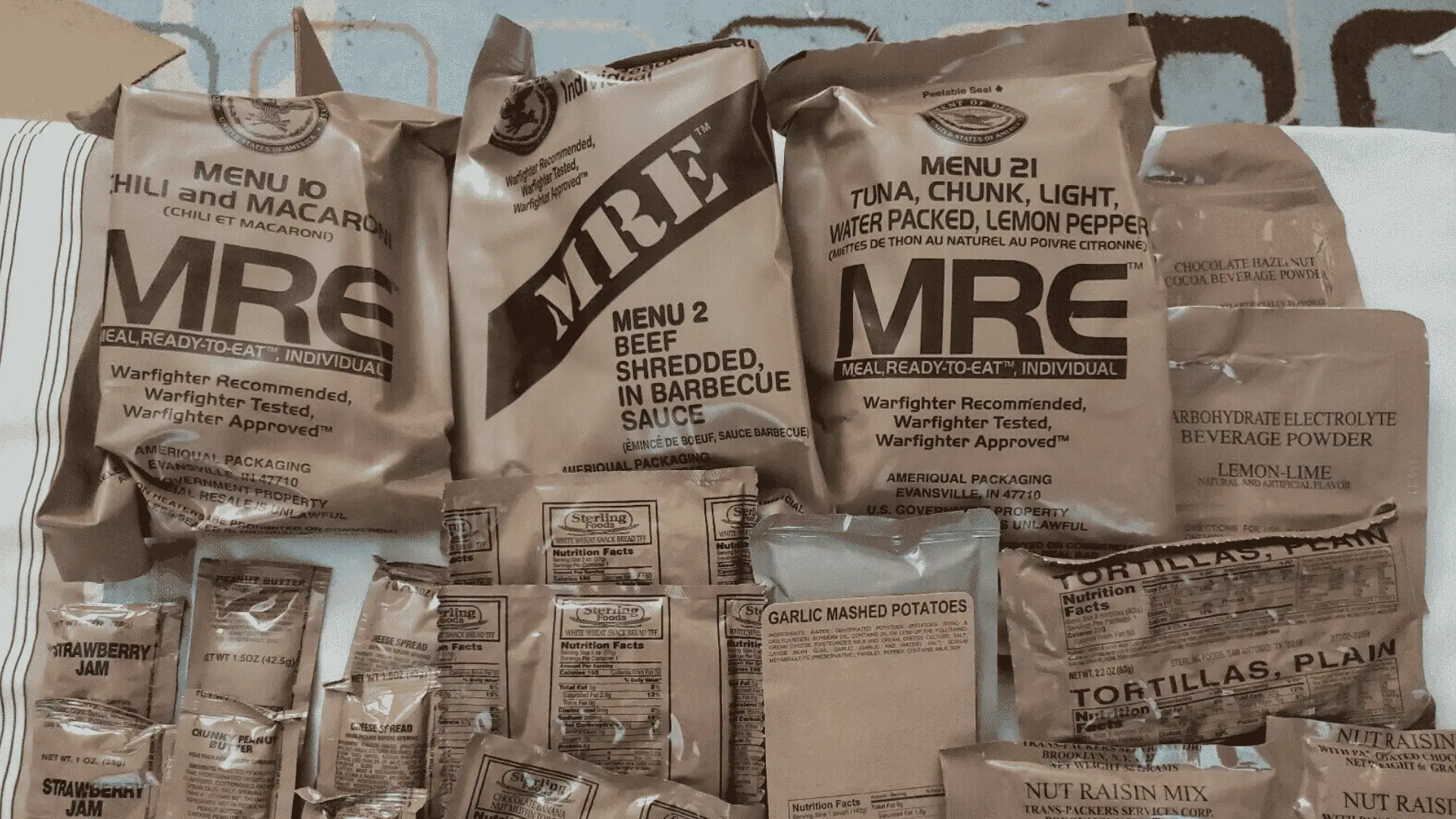Unless you grew up in a military family you probably don’t have any experience with MRE’s(Meal Ready to Eat). I’m not going to lie to you, I didn’t have a lot of experience with MREs growing up. I didn’t get to try one until my cousin came back from basic training. He knew that I was an avid backpacker so it seemed like the perfect gift. Are MRE’s good for camping and backpacking?
Although there are lighter food options MREs are really good for camping and backpacking. They pack a ton of calories (average 1250 calories) into a fairly lightweight package. They’re ready to eat right out of the package so you don’t need to bring cooking supplies when using MREs.
The only downside is the water weight absorbed into the food adds weight to your pack. Whether or not it’s worth the added weight depends on if you’re carrying cooking gear for other meals. MREs only make sense if you plan on leaving cooking gear at home. Freeze Dried meals are a lighter option if you’re already carrying cooking supplies.
Table Of Contents
Using MRE’s For Camping and Backpacking
Most campers and backpackers will eventually consider purchasing MREs to take on their trip. They’re a calorie packed self-contained meal that’s quick and easy to prepare. So it seems like a perfect choice for camping and backpacking. You can eat an MRE right out of the bag with minimal prep involved.
As the name suggests, MREs stand for “Meals Ready To Eat”. It’s 1200ish calorie meal that you can eat right out of the bag without any prep work involved. An MRE usually includes an entree, side dish, crackers or bread, some kind of spread (peanut butter, jelly, or cheese), dessert, candy, drink mix, seasoning (hot sauce or seasoning), and silverware.
They don’t even require a backpacking stove to heat them up since there’s a flameless ration heater included in the package. I don’t have to explain why that would be nice on a backpacking or camping trip. Carrying an MRE will cut down weight on short camping trips, but carrying multiple heaters/utensils and all that extra packaging adds weight to your pack on longer trips.
Honestly, I have a love/hate relationship when it comes to camping with MREs. It’s really nice to have a versatile high quality dinner that’s already ready to eat, but they add a lot of weight to your pack on longer trips. Carrying dehydrated meals will almost always be cheaper and lighter than an MRE.
A Few Problems With Carrying MREs On Camping Trips
While MREs make preparing dinner simple in the backcountry, they do have a few problems.
- Weight: Most MREs weight about 1lb, so they aren’t what I would consider lightweight. The only time the added weight makes sense is if you’re only eating MREs and can leave your stove at home.
- Flavor: There are a wide variety of MREs available. Some of them are fairly tasty, but others are downright nasty. They basically taste like cheap frozen dinners so don’t expect a gourmet meal.
- Cost: You can’t get around the cost of an MRE. The convenience of a well thought out dinner is nice, but there will always be cheaper dinners available.
- Lots of Packaging: Every single piece of food in an MRE comes with its own packaging. You will have lots of wrappers to keep track of and pack out after your meals.
- Shortish Shelf Life: I was surprised to learn that most MREs only have a 2-3 year shelf life. That’s fine if you’re buying them specifically for a trip, but don’t buy them in bulk.
Why I Like to Carry MREs
MREs make life easy out on the trail. Since you don’t need to tote around a bunch of cookware you can really save some weight. You can leave your cooking stove, fuel, cookware and utensils all at home. MREs are ready to eat right out of the package and they’re surprisingly lightweight(though they aren’t dehydrated).
Don’t get me wrong, I don’t always choose an MRE over traditional backpacking foods. I always bring a stove when setting up camp close to my car and when I plan on being on the trail more than a few days.
There’s a fine line between saving weight by leaving your cooking supplies at home and the additional weight of MREs(water included) over dehydrated dinners. You only have an advantage on short 2-3 day trips.
MREs Aren’t Perfect
Weight is by far the biggest downside to prepackaged MREs. Unlike MREs most ready to go backpacking meals come completely dehydrated. Add a little water and they’re ready to cook.
Your MRE is ready to go right out of the package so it has a little bit of water weight. On extended week-long trips, that adds up to a lot of weight.
Military Doesn’t Backpack With MREs
Most people are surprised to find out that the military doesn’t actually backpack with MREs. They only bring them along when they have motorized access and logistical support of the US Military.
When the US Military backpack they often take meals that aren’t too different than commercial freeze dried backpacking products. They’re actually made by the same company that packages Mountain House Meals(check them out they’re really good for the price).
Where to Buy MREs
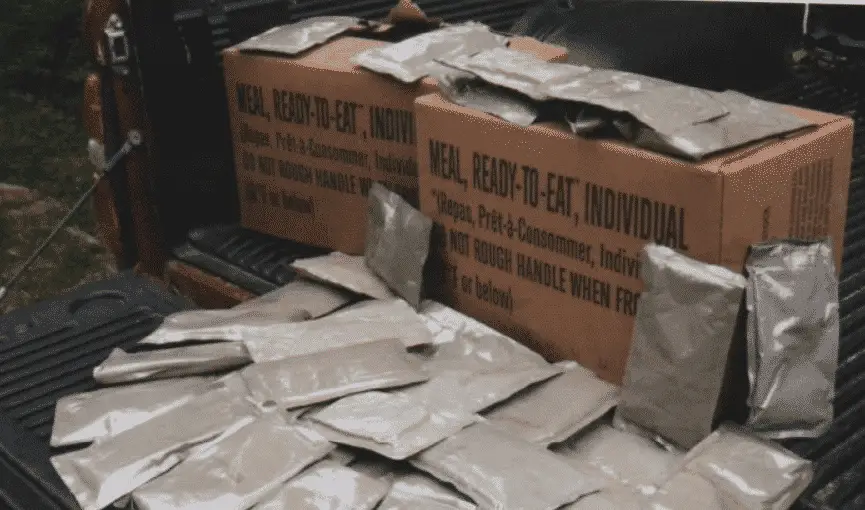
Unless you live on a military base you probably don’t have easy access to MREs(head down to your local military BX or surplus store). The rest of us can find prepackaged MREs online.
Just make sure you’re buying from a website that goes through a lot of product. Personally, I shop for mine on Amazon. There are a huge selection and lots of different flavors. I’ve found that Western Frontier tastes the best, but genuine US Military Rations seem to be the cheapest.
Unless you go to a local military supply MREs are sold in bulk boxes. That kind of stinks since you can’t pick out the exact meals you want. If you go with this supplier you can actually choose the individual meals, but it’s not cheap.
Are MREs Worth It?
MREs really are a great development in the emergency food supply. If you remember C and K Rations from the old days you’d be amazed at what kind of treat they can be.
The only problem is MREs aren’t great in a mobile survival scenario. They simply weigh too much to supply adequate nutrition for more than 3-4 days. If you’re keeping you don’t plan on going on long trips they’re great.
The problem with carrying MREs as part of your survival kit is that it adds weight to your load. So your goal should be to carry a food supply that has maximum nutrition per pound of weight. Other than the actual food the majority of the weight comes from packaging and water.
Package volume is another major concern for backpackers. When packing space is limited you really need to make sure you’re getting the most nutritional value in a given space. With MREs you can ditch your cooking equipment to recuce weight and open up space, but it’s a losing battle on longer trips.
I always listen to the US Military on their recommendation(I’m sure they have mathematicians figuring this stuff out). They state that MREs only make sense when traveling for 3 days or less. After 3 days go with dehydrated options since the additional weight will slow you down.
9 Reasons Why MREs Are Better Than Dehydrated Meals
If you’ve never eaten a MRE you’d probably think that they’re the same thing as backpacking meals. While they are similar it’s two completely different things. They are both lightweight meals, but that’s about as far as the similarities go.
1) They Have More Calories
If you look at traditional backpacking meals most of them only have 400-600 calories. They’re designed to be a supplement to the rest of your food rations. On the other hand, all military grade MREs are guaranteed to have at least 1200 calories.
So even though they might cost a little more you actually get 2-3 times the amount of calories. Survival comes down to calories in vs calories burned(it’s as simple as that).
2) Come With a Flameless Heater
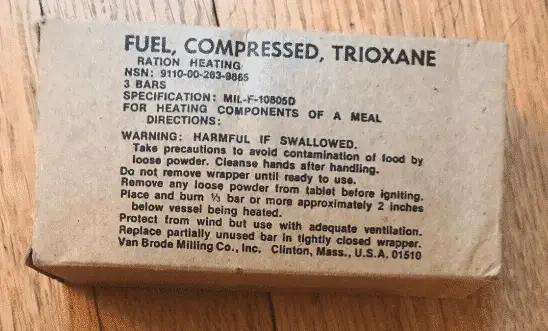
All MREs come with a flameless heater to quickly heat up your rations. It doesn’t matter if it’s raining, freezing, windy, high altitude or whatever the heater will work.
Just tear open your heater pouch, add your entree/water and wait. Within minutes you’ll have a fully cooked meal. Plus you don’t have to carry around all your cooking gear. No more packing a bulky stove, fuel, bowls and utensils.
3) Includes Sides
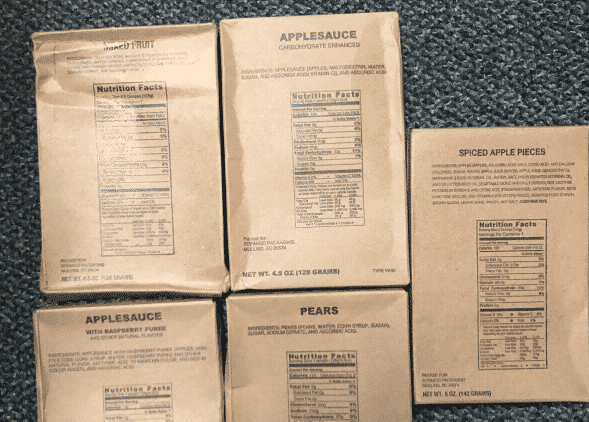
Every standard-issue MRE comes with a perfectly matched side dish. Backpacking meals only come with the main entree so it lacks variety. With a MRE you typically get a high carb/calorie side. It’s normally fruit, vegetables, rice or potato.
4) Dessert
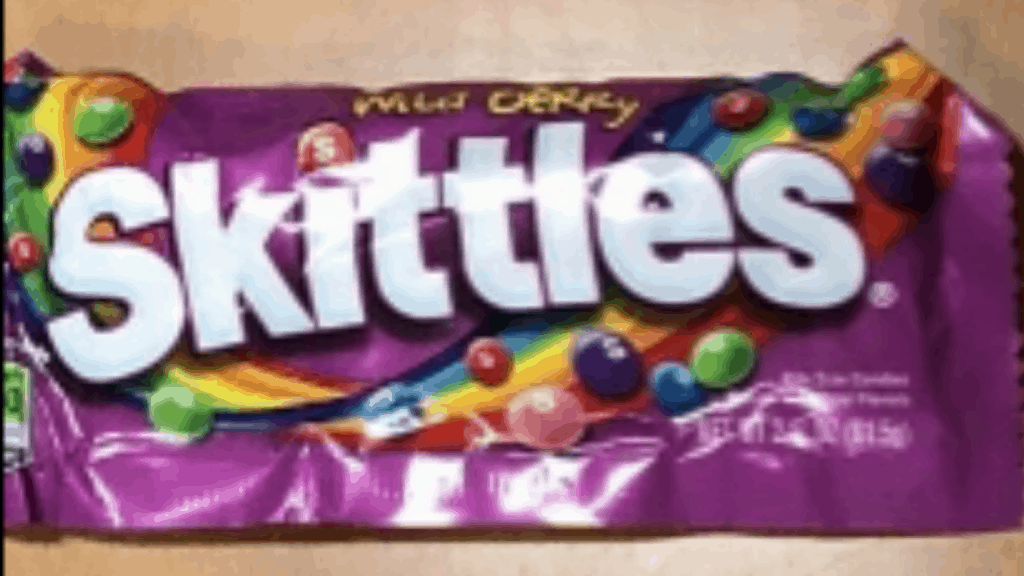
Every MRE that I’ve tried has come with some kind of dessert. They always come with both candy and some type of easy to make dessert package. Who doesn’t want sweet desserts miles away from civilization.
5) Breads/Crackers and Spreads
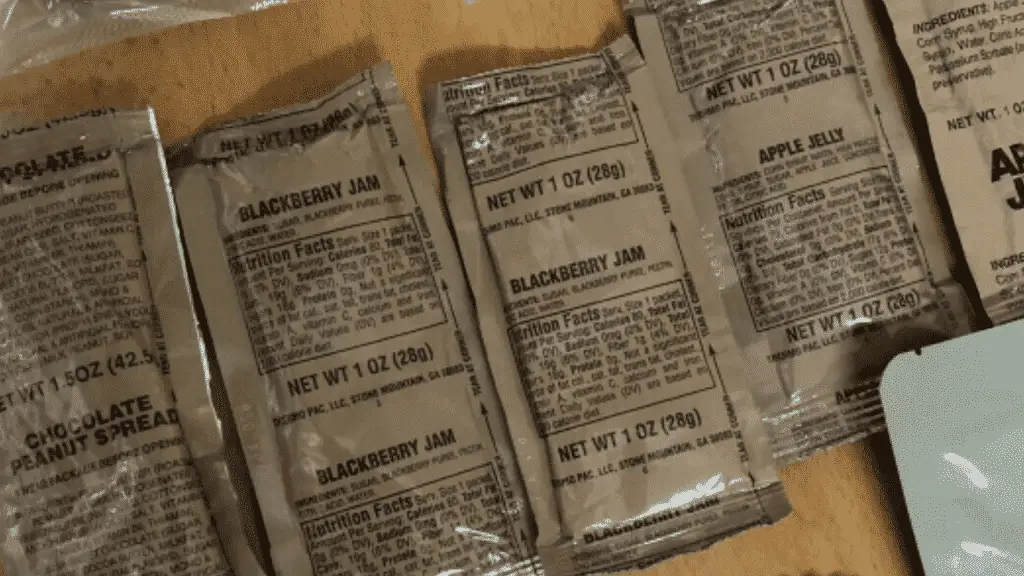
You always get some type of cracker or bread included in every meal. It’s a high carb snack that really pushes your meal over the edge. As an added bonus you almost always get some type of spread to put on top. Most of the time it’s a package of peanut butter, jelly or cheese. You’ll never get that in a backpacking meal.
6) Drink Mix
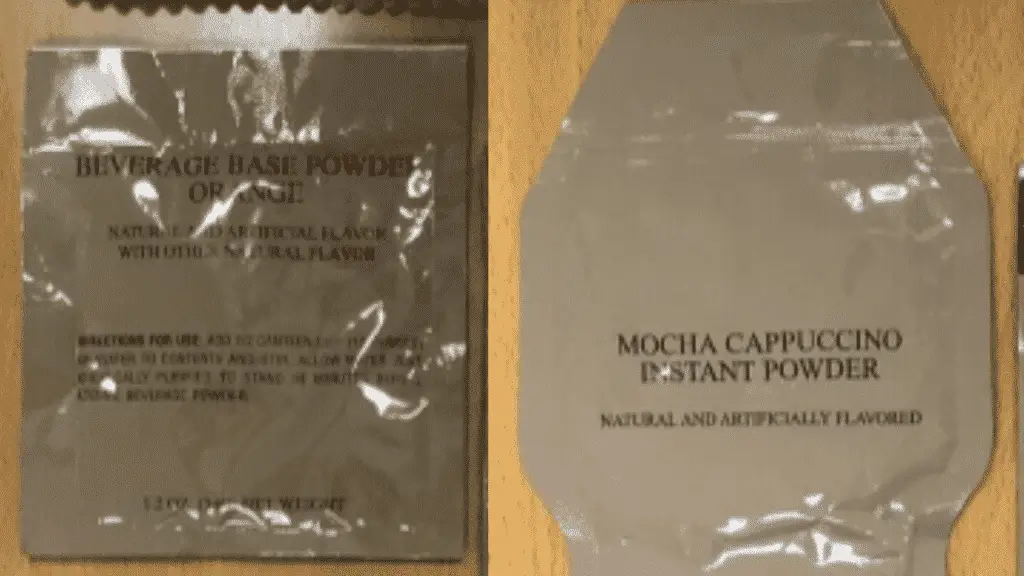
I’m usually sick of the warm water in my hydration bladder by the end of the first day. In every MRE you get some type of powdered drink mix. What you get really depends on the type of meal. Breakfast meals will almost always include coffee/tea, while dinners typically have some type of powdered sports drink.
7) Comes With Lots of Extras
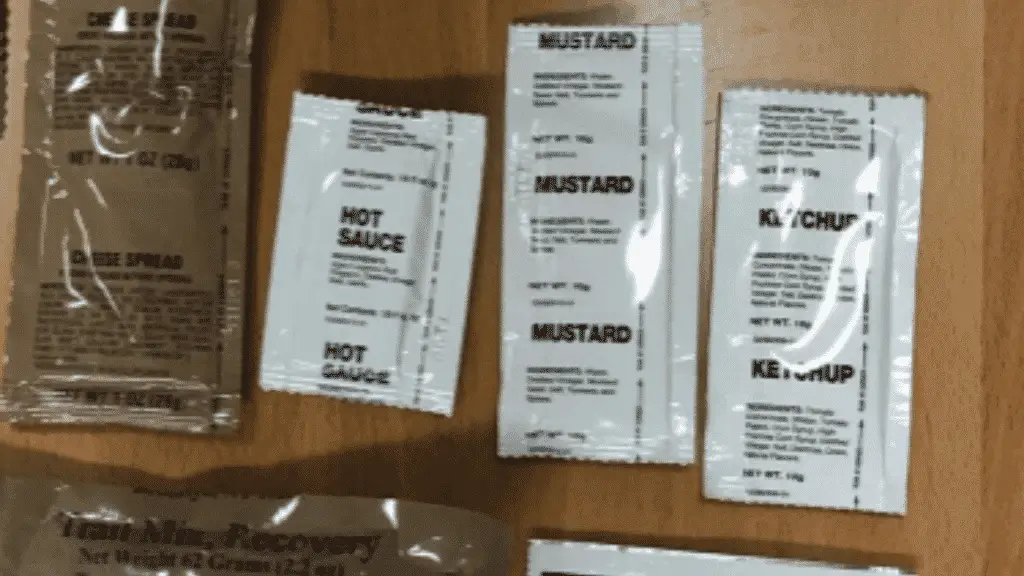
You get an accessory packet that includes everything that you need to enjoy your meal. It includes your silverwear, condiments, hot sauce, salt/pepper, toilet paper, matches, gum and wet wipes. It’s an all in one packet of everything the US Military thinks you’d need to survive in the field.
8) Affordable
It might not seem like it but MREs are surprisingly affordable. At about 5 bucks a pop when you buy a box it’s really not that bad. Think about how much the fuel for your backpacking stove costs.
You don’t have to buy food/snacks or bring along cleaning supplies. Everything is included in one handy little pack. Plus that little packet of completely dry toilet paper has saved my butt more times than I can count.
9) Lightweight
When compared to freeze-dried backpacking meals your MRE doesn’t look all that light. Most of them weigh just under a pound, while dehydrated meals are closer to 4oz they’re 1/2 the calories.
So for the same amount of calories, it’s about twice the weight. You have to remember that you don’t have to carry a backpacking stove, fuel canister, utensils and pots/bowls. When you subtract all that extra weight from your pack it comes out even on short trips. However, the weight start to shift back towards dehydrated meals after 4 or 5 days on the trail.
